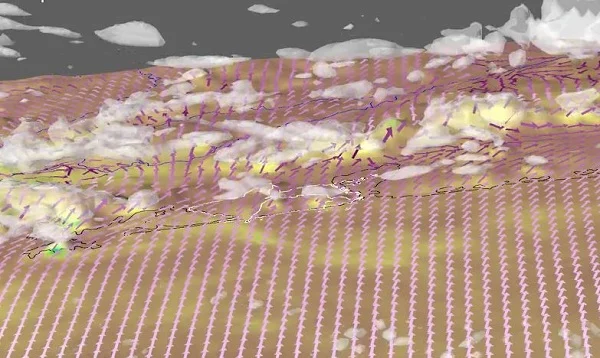Making wind and solar power – with their here-one-minute and gone-the-next tendencies – more reliable grid contributors usually leads to a discussion of energy storage.
But IBM is putting the focus on a well-known but less sexy factor: forecasting. The company today announced “an advanced power and weather modeling technology that will help utilities increase the reliability of renewable energy resources.”

Screen grab from IBM video
This is a project that was unveiled through IBM’s Armonk, N.Y., headquarters but is being put to the test already in China, where State Grid Jibei Electricity Power Company (SG-JBEPC), a subsidiary company of the State Grid Corporation of China (SGCC), is using the system, called HyRef, to integrate renewable energy into the grid, IBM said. This is at the Zhangbei demonstration project, which aims to combine solar and wind to the tune of 670 megawatts of generation capacity.
As IBM describes it, its new technology uses the latest meteorological information-gathering tools as well as big data analytics to give grid operators more foresight into the sometimes fickle contributions of solar and wind:
“Hybrid Renewable Energy Forecasting” (HyRef) uses weather modeling capabilities, advanced cloud imaging technology and sky-facing cameras to track cloud movements, while sensors on the turbines monitor wind speed, temperature and direction. When combined with analytics technology, the data-assimilation based solution can produce accurate local weather forecasts within a wind farm as far as one month in advance, or in 15-minute increments.
These forecasts don’t allow wind or solar projects to produce more power, at least not technically. But with grid operators saying 20 to 40 percent of renewable power can go to waste due to the instability of the sources, getting an extra chunk of the power that is produced onto the grid is as good as generating more. According to IBM:
By utilizing local weather forecasts, HyRef can predict the performance of each individual wind turbine and estimate the amount of generated renewable energy. This level of insight will enable utilities to better manage the variable nature of wind and solar, and more accurately forecast the amount of power that can be redirected into the power grid or stored. It will also allow energy organizations to easily integrate other conventional sources such as coal and natural gas.
IBM isn’t alone in trying to improve forecasting technology in the service of more efficient use of renewable energy. Last summer we wrote about solar forecasting devices that sound a lot like what IBM is using, called “sky imagers,” that have been implemented at the Solar 1 plant in Boulder City, Nev. These devices scan the skies using a fish-eye lens for a 360-degree view of the horizon and the collected data is then used to generate a 3-D weather model of the upcoming 15 minutes. And on the wind front, among other projects researchers are working to develop forecasts of atmospheric stability – which can have a big influence on power generation – at wind farm sites in order to help operators better estimate how much power a facility is likely to generate at a given time.






